Key Mercy Symbols
Symbols and celebrations play an important part in enabling and defining Mercy culture and identity.
They speak of what is held dear, what is valued. They have emerged from Mercy’s biblical and cultural traditions transcending geography and time and passed down by our ancestors in Mercy.
Symbols make visible the invisible, they inspire and inform, orientating Mercy relationships and culture. They are central to Mercy’s founding myths and meaning system, grounded in the Gospel and recognised in the ordinary events of each day.
The Mercy Cross
The Mercy Cross is worn by Sisters of Mercy throughout the world as a symbol of their vowed commitment. Sisters receive the Mercy Cross  when first vows are made.
when first vows are made.
‘A Cross-Within-a-Cross.’
The super-imposed pair of crosses on which the design is based, originates with Mercy foundress Catherine McAuley, who connected an ebony cross with an inset of a small ivory cross.
She believed each sister must take up her own cross and symbolically place herself upon it, for only by offering her sufferings for others is she truly showing them mercy.
Te Ngākau Atawhai
Heart of Mercy
In this bronze sculpture, the Mercy Cross, central to Catherine McAuley’s spirituality and recognised internationally as the symbol of her congregation, is supported by a pair of koru, the unfolding shoots of the New Zealand fern, among Earth’s oldest flora. 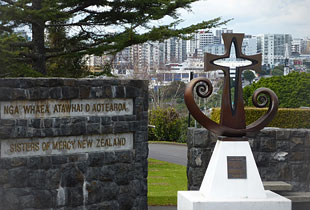
Reaching towards the light and forming the shape of a heart, the koru represent the unfolding of new life, creation’s power to renew and regenerate itself. In sustaining the cross, the fern shoots signal life that continues to grow in the face of death, finding purpose in chaos and giving new reason for hope. It is by embracing each and every cross that mercy brings life.
The fern is an indigenous species that links our Mercy story with the spirituality of Māori and the ancient lore of this land. The demands of justice, especially those that stem from Treaty violation and the loss of mana and land that Māori have sustained, are part of this story. Mother Cecilia Maher, for whom “the fire in the fern” meant the simmering tensions between Māori and pākehā settlers that threatened bloodshed and war, would have seen in this symbol the promise of peace that only justice can bring.
The link between the koru and the cross is also an invitation to change our world by changing our story. The cross has long stood as a sign of atonement and redemption. In our time, the cross needs to be seen more as a symbol of ongoing creation. The God of the cosmos is not a God who requires humans to suffer, but who instead reveals love as the one power that can make sense of suffering, even death itself. “The only return required of us for all God’s favours,” says Catherine McAuley, “is the return of love.” Te Ngākau Atawhai Heart of Mercy is an invitation to ponder that truth.
Artist: Gael O’Leary, 2003
Te kōwhaiwhai o Nga Whaea Atawhai o Aotearoa
Sisters of Mercy New Zealand
Te Raranga Atawhai Mercy Weave is the congregation kōwhaiwhai seen at the top of the home page of this website. It symbolises new strands of Mercy unfurling as together we seek to be centred in the God of Mercy.
Artist: Kingi Davis, 2009
Catherine McAuley’s ‘Good Cup of Tea’
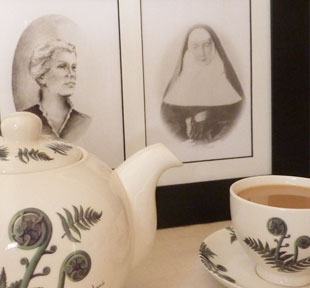 Catherine McAuley died in Dublin on 11 November, 1841 surrounded by her sisters. In her last moments Catherine directed that the sisters would have a ‘good cup of tea’ together in the community room, after she had gone.
Catherine McAuley died in Dublin on 11 November, 1841 surrounded by her sisters. In her last moments Catherine directed that the sisters would have a ‘good cup of tea’ together in the community room, after she had gone.
The tradition of a ‘good cup of tea’ helps keep the spirit of Catherine alive today for sisters, companions and all we meet in ministry.
In the Aotearoa New Zealand context it expresses the core Mercy value of te manaakitanga hospitality.
Doors of Mercy
Baggot St House of Mercy’s door first opened in 1827 and provided educational, 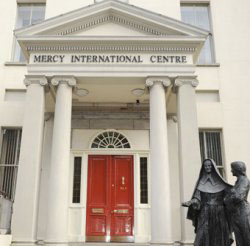 employment opportunities and social services for women and children at risk of homelessness, and entrenched poverty. The opening of that door has inspired the opening of Mercy doors in over 40 countries.
employment opportunities and social services for women and children at risk of homelessness, and entrenched poverty. The opening of that door has inspired the opening of Mercy doors in over 40 countries.
Now the home of Mercy International Association, Baggot Street House of Mercy is a place of pilgrimage and reflection for Sisters of Mercy and companions from around the world, as they seek to live Mercy as a creative response to the needs of our time.
The Shawl of Tender Mercy
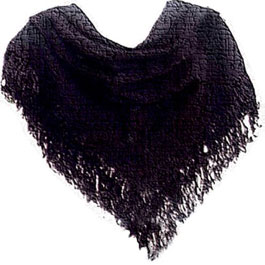
Late one night in 1832, Catherine carried home in her arms, wrapped in her black woollen shawl, the newborn baby of a poor woman who had died of cholera. Catherine put the baby to sleep in her own room.
‘To share ones shawl is to reach out, side by side, and embrace the shoulders and life and needs of another.’ Mary Sullivan rsm
The Homemade Boots
The boots made at Baggot Street and worn by the Sisters are a symbol of the ‘walking nuns’. 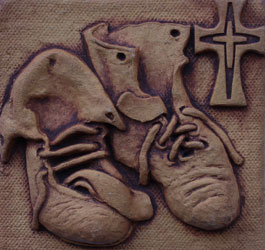 Catherine and her sisters walked to city hovels, hospitals and thatched cabins, in slum alleys, through snow and mud, any place where people were suffering.
Catherine and her sisters walked to city hovels, hospitals and thatched cabins, in slum alleys, through snow and mud, any place where people were suffering.
Catherine’s mercifulness reached out to the edges of her time. Today who is calling us from the edges and to a willingness to reach out and walk in the shoes of another?

